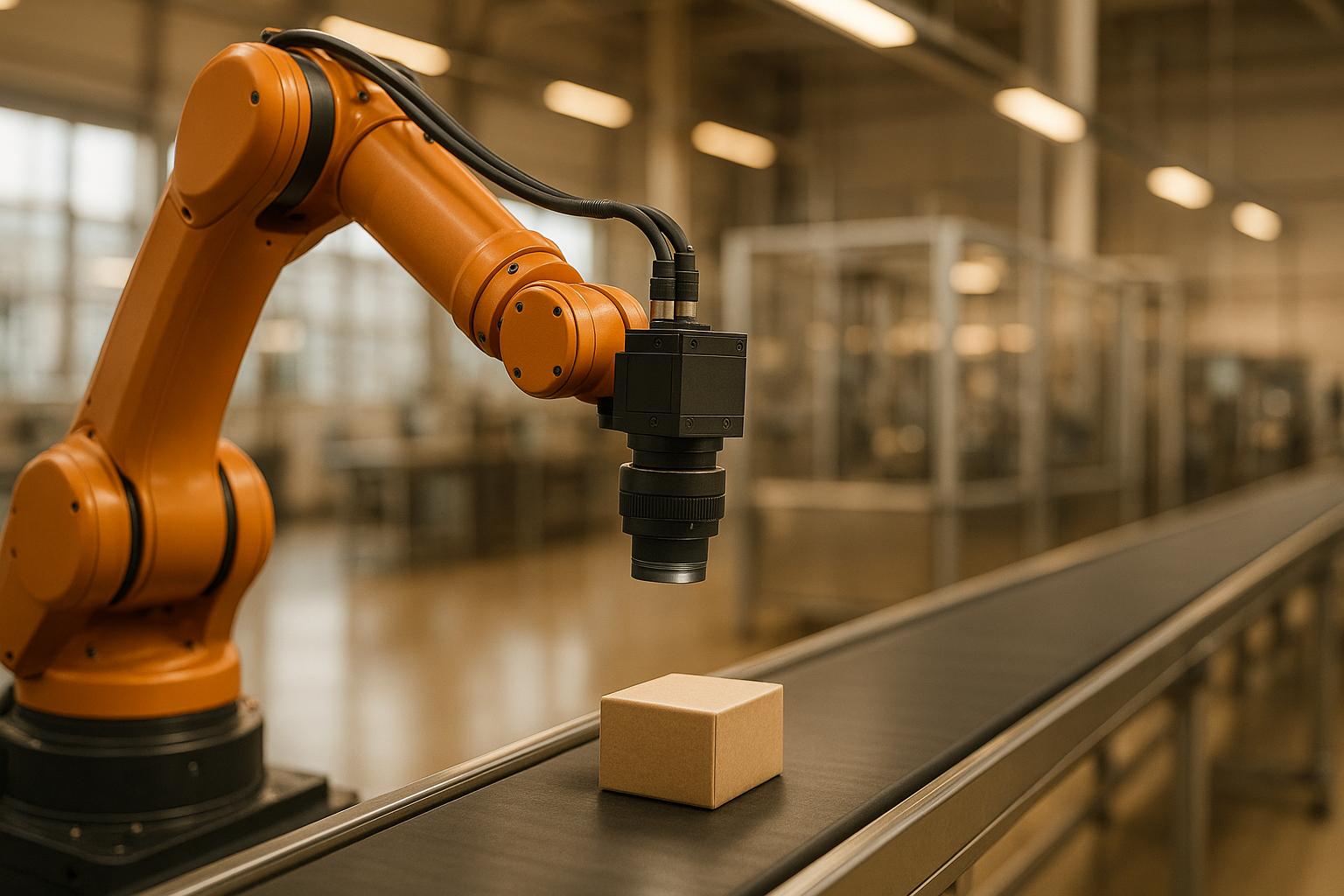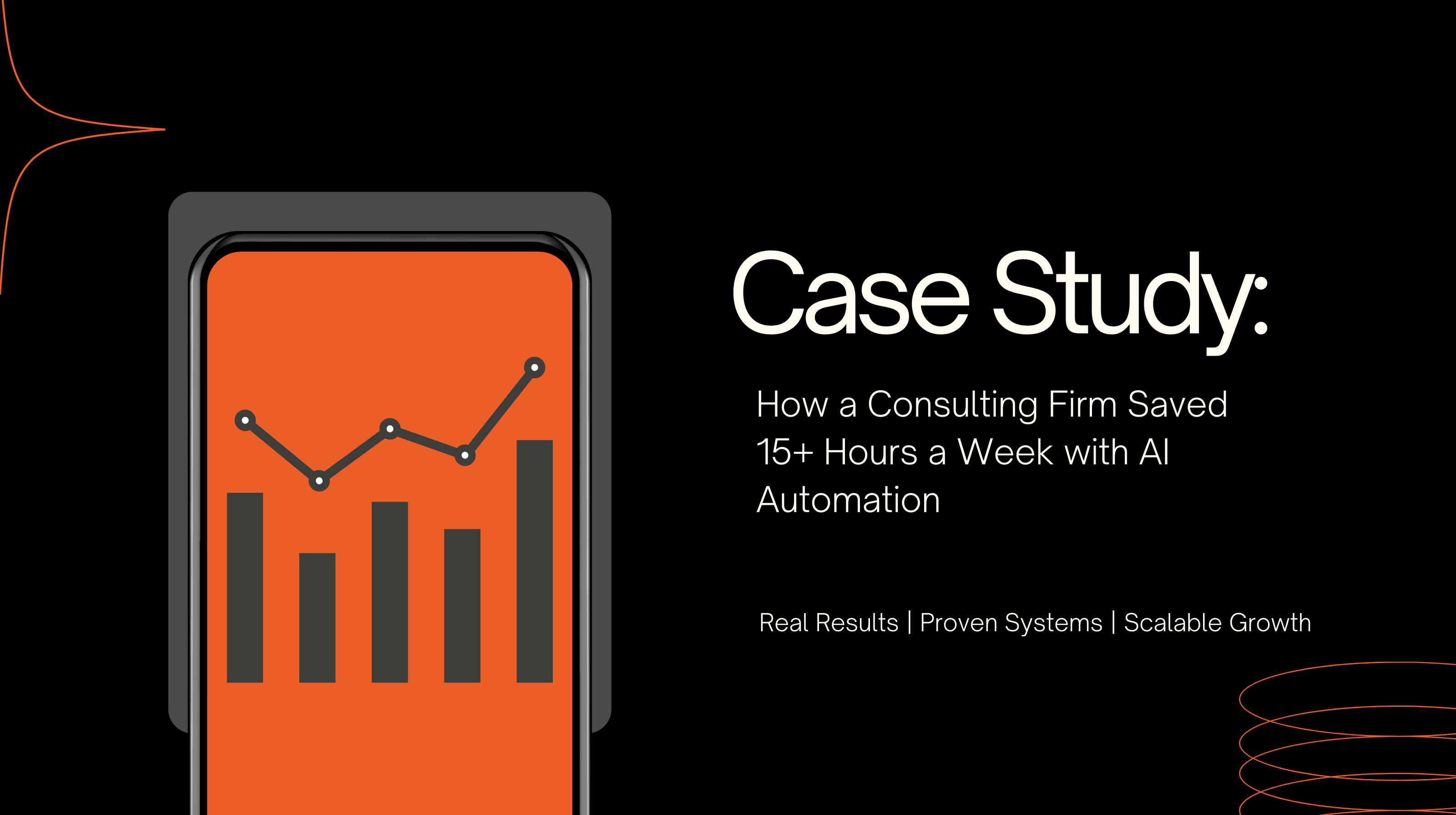Computer vision is transforming quality control by replacing manual inspections with AI-driven systems that are faster, more accurate, and cost-effective. Here’s why it’s a game-changer:
For example, a pharmaceutical company using AI inspected 300 vials per minute with 99.5% accuracy, tripling the speed of manual methods. Businesses integrating computer vision gain better defect detection, reduced waste, and improved productivity.
🔍 AI-Powered Visual Quality Inspection in Continuous Production Lines
Main Uses of Computer Vision in Quality Control
Computer vision has reshaped quality control processes in manufacturing by tackling three core challenges: identifying surface defects, ensuring precise measurements, and verifying product attributes. These applications demonstrate how computer vision enhances accuracy and efficiency, setting the foundation for strategies discussed later.
Surface Defect Detection
One of the standout uses of computer vision is its ability to detect surface defects. These systems spot scratches, cracks, dents, and discoloration on a wide range of materials. Unlike manual inspections, computer vision ensures consistent and thorough detection across all products.
This technology finds applications across various industries. In automotive manufacturing, it checks car parts for imperfections, misalignments, and paint quality issues. In electronics manufacturing, it examines printed circuit boards (PCBs) and components for soldering errors, misplaced parts, and surface flaws. The textile industry uses it to identify fabric issues like tears, stains, or color mismatches, while metal and steel manufacturers rely on it to inspect for scratches, cracks, rust, and other defects.
The results speak for themselves. Companies using machine vision systems for defect detection have reported an 86% reduction in critical defects per release and a 40% boost in customer satisfaction. By catching defects early, these systems also help cut down on waste and rework costs.
"Visionify's Automated Visual Inspection system has completely transformed our quality control process. We're now able to inspect 100% of our products with a level of consistency and accuracy that was impossible with manual inspection. The reduction in customer complaints and warranty claims alone justified the investment, but we've also seen significant improvements in production throughput and cost efficiency."
Size and Shape Inspections
Dimensional accuracy is another critical area where computer vision excels. These systems use high-resolution imaging to analyze dimensions and alignment, achieving over 95% defect detection accuracy. They can identify deviations from standard measurements, irregular edges, and uneven dimensions.
Modern computer vision systems powered by AI adapt to changing conditions, unlike traditional systems that rely on fixed rules and work best in stable environments. This flexibility leads to greater accuracy and faster processing, making them ideal for complex manufacturing environments.
"By enabling machines to 'see' and analyze visual data, computer vision overcomes the inefficiencies of traditional methods. Using AI-powered algorithms, it can detect defects, measure product dimensions and verify compliance with astonishing speed and precision - far beyond human capability."
This ability to ensure precise measurements complements other quality checks, creating a comprehensive approach to quality control.
Product Attribute Verification
Computer vision systems also excel at verifying product attributes such as size, shape, color, texture, and pattern. This technology replaces subjective human evaluations with consistent, objective assessments of product quality.
These systems are particularly adept at identifying subtle issues that might escape human notice. Machine learning algorithms, trained on extensive datasets, can distinguish between acceptable and defective items. For instance, they evaluate color uniformity and texture to detect discoloration, fading, or rough surfaces. Additionally, they spot misalignments or inconsistencies in intricate patterns, ensuring uniformity across products.
In the food and beverage industry, computer vision inspects the size, shape, and alignment of packaged goods to ensure they meet branding standards. It also analyzes labels for misprints or misalignments that could harm a brand's image. Similarly, pharmaceutical companies rely on these systems for high-volume tablet and pill inspections, preventing defects that could lead to costly recalls.
"KEYENCE's VS Series provides superior functions that enable pharmaceutical companies to inspect high-volume tablets or pills individually, preventing undetected defects and avoiding recalls."
Businesses that adopt computer vision for quality checks report a 90% improvement in detecting defective items. This boost in detection rates leads to less waste, fewer customer complaints, and a stronger reputation for quality.
How to Implement Computer Vision in Quality Control
Using computer vision in quality control can significantly improve defect detection and streamline production processes. In fact, 77% of manufacturers acknowledge its importance for achieving their business goals. To make the most of this technology, a structured approach is essential. The process typically involves three key phases, each building on the last to create an effective quality control system.
Data Collection and Image Setup
The success of your computer vision system starts with high-quality and consistent image data. These images determine how well your AI can differentiate between acceptable and defective products. Poor-quality images could lead to false positives or missed defects.
To get started, use high-resolution cameras and ensure proper lighting for clear, detailed images. Position cameras strategically to capture products from multiple angles, and maintain consistent image quality and resolution throughout your dataset. Collect these images directly from the production line where the system will operate. This ensures your training data matches the real-world conditions the AI will face. Include variations in lighting, product orientation, and production speeds to create a dataset that mirrors actual manufacturing scenarios.
Accurate data annotation is another critical step. Depending on your needs, you might use bounding boxes for object detection, polygons for irregular shapes, or classification labels for categorizing images. Mislabeling can significantly reduce model performance - research from the MIT-IBM Watson AI Lab shows mislabeled data can cut accuracy by up to 50%.
To further enhance your dataset, apply data augmentation techniques like rotating, flipping, scaling, or adjusting brightness. These methods expand your dataset without requiring additional images, helping your AI adapt to variations it might encounter during production. A well-prepared dataset sets the stage for effective model training.
AI Model Training and Image Analysis
Once you’ve collected and annotated your data, the next step is training your AI model. Convolutional neural networks (CNNs) are the backbone of image analysis in computer vision, capable of identifying patterns that signal defects.
Before training begins, define clear accuracy goals. What level of defect detection is acceptable? Some defects may demand near-perfect detection rates, while others might tolerate slightly lower thresholds based on their impact on product quality or customer satisfaction. Collaborate with teams from quality control, operations, and engineering early in the process to ensure the AI system addresses actual production challenges and integrates smoothly into existing workflows.
Training doesn’t stop after the initial phase. Continuously update the model with new production data to keep it effective as conditions evolve. A well-trained model that adapts to changes ensures consistent performance in detecting defects.
System Integration and Automation
Integrating your computer vision system into production is where the benefits truly come to life. Edge AI deployment, which processes image data locally rather than sending it to centralized servers, allows for real-time quality control. This means defective products can be identified and rejected instantly, reducing latency and improving efficiency.
A successful integration begins with a solid foundation - high-resolution imaging systems, calibrated sensors, and a robust data collection setup. The vision system should seamlessly connect with your existing manufacturing and quality control workflows to enable real-time decision-making.
For instance, BMW achieved a 30% reduction in defect rates within a year of implementing AI vision systems in one of their European plants. Similarly, Samsung Electronics saw a 31% drop in customer return rates within 18 months of adopting AI-powered quality control for semiconductor manufacturing.
Pilot programs are a smart way to test the system’s effectiveness before scaling up. In fact, 87% of successful AI quality control implementations began with focused pilot projects. Start small - perhaps on one production line or a specific product type - and use the results to refine the system before rolling it out across the entire operation.
Partnering with experienced professionals can also make the process smoother. Companies like Devcore specialize in creating custom AI and automation solutions tailored to existing manufacturing workflows, helping to address inefficiencies and ensure a successful deployment.
Before full deployment, plan for every detail. Train staff on how to use the system, establish maintenance routines, and create protocols for handling alerts or recommendations. This preparation ensures the system enhances production rather than causing disruptions.
Finally, prioritize cybersecurity. Your quality control system will handle sensitive production data, so robust security measures are essential to protect against data theft and system vulnerabilities. A secure, well-integrated system sets the stage for long-term success.
sbb-itb-d7ea0c6
Common Challenges and Solutions
While computer vision has transformed quality control processes, implementing it often comes with hurdles. Thankfully, these challenges can be tackled with the right strategies.
Getting Quality Image Data
The effectiveness of computer vision systems hinges on the quality of the image data they process. One common issue is variable lighting - objects can look drastically different under changing light conditions, especially during different production shifts. Other challenges include perspective changes, obstructions caused by packaging or equipment, and a lack of properly annotated data. Manual annotation, in particular, is time-consuming and often underestimated in terms of the resources it demands.
Several techniques can help address these challenges:
Clear annotation standards also play a key role in maintaining consistency. Together, these techniques help ensure that computer vision systems can work seamlessly, even when integrated into existing equipment.
Working with Existing Equipment
Bringing computer vision into older production setups can be tricky, but it’s far from impossible. Custom software solutions often serve as the bridge between advanced AI systems and legacy equipment. A phased deployment strategy - starting with small pilot projects - can validate the technology and build internal expertise before scaling up.
For example, an electronics manufacturer used this approach to cut missed defects by 30% while significantly reducing inspection times. Other companies have reported similar successes, with some achieving a 30% reduction in defect rates and slashing inspection costs by 30 times.
Cross-functional teams are essential to this process. Experts in manufacturing, computer vision, data science, and IT work together to assess current infrastructure and design flexible systems that can adapt to future needs. Companies like Devcore specialize in creating tailored AI solutions that integrate smoothly into existing workflows, ensuring minimal disruption to production schedules. This kind of integration not only maintains production levels but also strengthens quality control measures.
Cost Planning and Return on Investment
Technical hurdles aside, effective cost planning is key to reaping the long-term benefits of computer vision. Many companies make the mistake of focusing only on hardware and software costs, overlooking ongoing expenses like training, integration, and maintenance.
Smart strategies can help manage these costs:
Tracking performance through key performance indicators (KPIs) ensures that spending stays optimized over time. Adopting a portfolio approach to evaluate ROI can highlight the cumulative benefits of computer vision across all quality control operations.
Manual vs Computer Vision Quality Control
When it comes to quality control, computer vision excels in accuracy, speed, and consistency compared to manual inspection. Understanding the key differences between these methods allows businesses to make better decisions about upgrading their processes. Below, we’ll explore how each method performs across critical dimensions of quality control.
Comparison: Manual vs Computer Vision Methods
The differences between manual and computer vision inspection are stark, particularly in accuracy. Studies show that human inspectors miss up to 40% of defects, with detection rates ranging from 60% to 90%. Meanwhile, computer vision systems consistently achieve accuracy rates as high as 95% to 99.5%.
Consider this example: A leading car manufacturer adopted a machine vision system to inspect welds on car body panels. The result? A 30% boost in detection accuracy and a 50% reduction in inspection time. This system also eliminated variability caused by human fatigue, delivering consistent results across all shifts.
In the electronics sector, manufacturers report significant improvements in defect detection with computer vision. Similarly, a pharmaceutical company using an AI-driven machine vision system achieved a 99.5% defect detection rate, compared to 90% with manual inspection.
Speed and throughput are other areas where computer vision dominates. The same electronics manufacturer noted above reduced inspection time by 60%, which allowed for higher production rates. In pharmaceutical production, automated systems can inspect up to 300 vials per minute - three times faster than manual methods.
Here’s a quick summary of how the two methods stack up:
are major challenges for manual inspection. Human inspectors are prone to fatigue and subjective judgment, leading to variability over time. In contrast, computer vision systems operate around the clock with consistent performance, free from human error.
Scalability is another area where manual inspection falls short. High-volume manufacturing often relies on random sampling, meaning not every product is inspected. This increases the likelihood of defective items reaching customers. Computer vision systems, however, can inspect every product at production speed, ensuring comprehensive quality control.
When it comes to adaptability, computer vision systems also have the edge. Manual methods struggle to handle diverse product lines or adapt to new standards. AI-enhanced systems, on the other hand, can quickly learn new defect patterns and adjust to different product specifications.
Cost considerations further highlight the advantages of computer vision. While manual inspection has a lower upfront cost, its long-term labor expenses make it less economical. Automated systems, by contrast, offer significant savings. For example, industries using visual inspection report annual labor savings of $691,200 per production line. In one case, an automotive supplier saw a net annual benefit of $1,354,000 after implementing an AI-powered system, thanks to improved yield and reduced defect-related costs.
Additionally, computer vision minimizes inefficiencies caused by human error. AI-based systems can increase defect detection rates by up to 90% compared to manual methods, resulting in less waste, fewer reworks, and reduced customer complaints.
For companies considering this shift, market trends point to rapid adoption. The automated visual inspection systems market is projected to grow from $16.69 billion in 2024 to $19.04 billion in 2025, driven by advancements in technology and widespread industry demand.
Conclusion: Improving Quality Control with Computer Vision
Computer vision technology is transforming quality control processes across various industries, significantly improving inspection accuracy. For instance, accuracy rates have jumped from 63% to 97%, while automotive manufacturers have seen scrap rates drop by 25% and productivity rise by 21%.
Automated visual inspection systems also bring substantial cost savings, reducing inspection expenses by as much as 66%. This is a critical improvement, given that poor quality control can cost businesses 15-20% of their annual sales revenue. Real-time defect detection further enhances product quality while minimizing waste, making these systems especially valuable in high-volume manufacturing settings where every product must be inspected at production speed.
Such operational advantages have driven widespread adoption. Currently, 76% of senior manufacturing executives report using digital tools like AI and computer vision to refine quality control processes. The market for computer vision is expected to grow to $39 billion by 2029, with an impressive compound annual growth rate of 17.72%.
To fully leverage these benefits, businesses can turn to custom computer vision solutions tailored to their specific needs. These solutions adapt to evolving requirements and scale effortlessly to handle larger datasets. Devcore, for example, specializes in creating custom AI and automation systems designed to eliminate inefficiencies and deliver measurable business outcomes. Using their proprietary Leverage Blueprint™, Devcore helps businesses pinpoint operational challenges and seamlessly integrate computer vision into existing workflows.
FAQs
How does computer vision improve cost and efficiency compared to manual quality inspections?
Computer vision brings a host of advantages compared to traditional manual inspections, particularly when it comes to cutting costs and improving efficiency. While the upfront costs for hardware and setup might seem steep, the payoff is undeniable - lower labor expenses, fewer product defects, and reduced spending on rework or recalls.
This technology excels at spotting defects quickly and with a level of accuracy that manual inspections often struggle to achieve. By automating repetitive tasks, businesses can ramp up productivity, reduce human error, and implement a quality control process that's easier to scale. Over time, these benefits lead to noticeable savings and happier customers.
What challenges do companies face when using computer vision for quality control, and how can they address them?
Companies often face hurdles like uneven lighting, poor-quality data, low model accuracy, and the complexity of managing varied product types when using computer vision for quality control. These challenges can affect how dependable and scalable the system is.
To tackle these issues, businesses can start by improving data quality through thorough cleaning and validation methods. Adjusting lighting conditions to ensure consistent and clear imaging can also make a big difference. Using modular, scalable architectures helps systems adapt better over time. Cloud-based infrastructure is another game-changer, offering greater flexibility and boosting performance. Finally, tailoring solutions to accommodate specific product variations leads to more precise outcomes. By addressing these areas, companies can fully harness the power of computer vision in their quality control workflows.
What steps can businesses take to successfully integrate computer vision into their production workflows?
To bring computer vision into production workflows effectively, businesses need to begin with well-defined goals that match their operational priorities. It's also crucial to perform a detailed review of how the technology fits with current systems to prevent compatibility problems.
Equipping employees with the right training to collaborate with the new tools is another key step. This not only eases the transition but also ensures the technology is used to its fullest potential. Prioritize gathering high-quality data, closely tracking performance, and fine-tuning the system as necessary to achieve the best results. When planned and implemented thoughtfully, computer vision can greatly improve quality control and streamline operations.
Related posts
- Manual Workflows Slowing Growth? AI Solutions
- Ultimate Guide to Scaling Business with Automation
- How to Measure Automation ROI: 6 Key Metrics
- Custom AI Models for Predictive Analytics
{"@context":"https://schema.org","@type":"FAQPage","mainEntity":[{"@type":"Question","name":"How does computer vision improve cost and efficiency compared to manual quality inspections?","acceptedAnswer":{"@type":"Answer","text":"<p>Computer vision brings a host of advantages compared to traditional manual inspections, particularly when it comes to cutting costs and improving efficiency. While the upfront costs for hardware and setup might seem steep, the payoff is undeniable - lower labor expenses, fewer product defects, and reduced spending on rework or recalls.</p> <p>This technology excels at spotting defects quickly and with a level of accuracy that manual inspections often struggle to achieve. By automating repetitive tasks, businesses can ramp up productivity, reduce human error, and implement a quality control process that's easier to scale. Over time, these benefits lead to noticeable savings and happier customers.</p>"}},{"@type":"Question","name":"What challenges do companies face when using computer vision for quality control, and how can they address them?","acceptedAnswer":{"@type":"Answer","text":"<p>Companies often face hurdles like uneven lighting, poor-quality data, low model accuracy, and the complexity of managing varied product types when using <strong>computer vision</strong> for quality control. These challenges can affect how dependable and scalable the system is.</p> <p>To tackle these issues, businesses can start by improving <strong>data quality</strong> through thorough cleaning and validation methods. Adjusting <strong>lighting conditions</strong> to ensure consistent and clear imaging can also make a big difference. Using modular, scalable architectures helps systems adapt better over time. Cloud-based infrastructure is another game-changer, offering greater flexibility and boosting performance. Finally, tailoring solutions to accommodate specific product variations leads to more precise outcomes. By addressing these areas, companies can fully harness the power of computer vision in their quality control workflows.</p>"}},{"@type":"Question","name":"What steps can businesses take to successfully integrate computer vision into their production workflows?","acceptedAnswer":{"@type":"Answer","text":"<p>To bring computer vision into production workflows effectively, businesses need to begin with <strong>well-defined goals</strong> that match their operational priorities. It's also crucial to perform a <strong>detailed review</strong> of how the technology fits with current systems to prevent compatibility problems.</p> <p>Equipping employees with the right <strong>training to collaborate with the new tools</strong> is another key step. This not only eases the transition but also ensures the technology is used to its fullest potential. Prioritize gathering high-quality data, closely tracking performance, and fine-tuning the system as necessary to achieve the best results. When planned and implemented thoughtfully, computer vision can greatly improve quality control and streamline operations.</p>"}}]}




